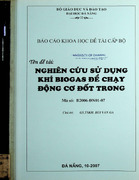
Please use this identifier to cite or link to this item:
http://thuvienso.dut.udn.vn/handle/DUT/199| Title: | Nghiên cứu sử dụng khí biogas để chạy động cơ đốt trong | Authors: | Bùi, Văn Ga, GS.TSKH Trần, Văn Nam, PGS.TS Trương, Lê Bích Trâm, KS Ngỗ, Văn Lành, KS Lê, Minh Tiến, KS Trương, Hoàn Thiện, KS Đặng, Hữu Thành, KS |
Keywords: | Báo cáo khoa học đề tài cấp Bộ;Khí biogas;Động cơ đốt trong | Issue Date: | Oct-2007 | Publisher: | Đại học Đà Nẵng | Description: | BC. Mã số: B2006-ĐN01-07; 121 tr |
URI: | http://thuvienso.dut.udn.vn/handle/DUT/199 |
| Appears in Collections: | Đề tài nghiên cứu khoa học cấp Nhà nước - Bộ |
Files in This Item:
| File | Description | Size | Format | Existing users please Login |
|---|---|---|---|---|
| 4.BC.71022.BUIVANGA.pdf | Toàn văn | 35.42 MB | Adobe PDF |  |
CORE Recommender
Items in DSpace are protected by copyright, with all rights reserved, unless otherwise indicated.